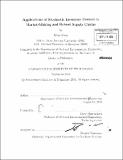| dc.contributor.advisor | David Simchi-Levi. | en_US |
| dc.contributor.author | Song, Miao, Ph. D. Massachusetts Institute of Technology | en_US |
| dc.contributor.other | Massachusetts Institute of Technology. Dept. of Civil and Environmental Engineering. | en_US |
| dc.date.accessioned | 2011-04-04T16:16:56Z | |
| dc.date.available | 2011-04-04T16:16:56Z | |
| dc.date.copyright | 2010 | en_US |
| dc.date.issued | 2010 | en_US |
| dc.identifier.uri | http://hdl.handle.net/1721.1/62049 | |
| dc.description | Thesis (Ph. D.)--Massachusetts Institute of Technology, Dept. of Civil and Environmental Engineering, 2010. | en_US |
| dc.description | Cataloged from PDF version of thesis. | en_US |
| dc.description | Includes bibliographical references (p. 169-172). | en_US |
| dc.description.abstract | This dissertation extends the classical inventory control model to address stochastic inventory control problems raised in market-making and robust supply chains. In the financial market, market-makers assume the role of a counterpart so that investors can trade any fixed amounts of assets at quoted bid or ask prices at any time. Market-makers benefit from the spread between the bid and ask prices. but they have to carry inventories of assets which expose them to potential losses when the market price moves in an undesirable direction. One approach to reduce the risk associated with price uncertainty is to actively trade with other Market-Makers at the price of losing potential spread gain. We propose a dynamic programming model to determine the optimal active trading quantity., which maximizes the Market-Maker's expected utility. For a single-asset model. We show that a threshold inventory control policy is optimal with respect to both an exponential utility criterion and a mean-variance tradeoff objective. Special properties such as symmetry and monotonicity of the threshold levels are also investigated. For a multiple-asset model. the mean-variance analysis suggests that there exists a connected no-trade region such that the Market-Maker does not need to actively trade with other market-makers if the inventory falls in the no-trade region. Outside the no-trade region. the optimal way to adjust inventory levels can be obtained from the boundaries of the no-trade region. These properties of the optimal policy lead to practically efficient algorithms to solve the problem. The dissertation also considers the stochastic inventory control model in robust supply chain systems. Traditional approaches in inventory control first estimate the demand distribution among a predefined family of distributions based on data fitting of historical demand observations, and then optimize the inventory control policy using the estimated distributions. which often leads to fragile solutions in case the preselected family of distributions was inadequate. In this work. we propose a minimax robust model that integrates data fitting and inventory optimization for the single item multi-period periodic review stochastic lot-sizing problem. Unlike the classical stochastic inventory models, where demand distribution is known, we assume that histograms are part of the input. The robust model generalizes Bayesian model, and it can be interpreted as minimizing history dependent risk measures. We prove that the optimal inventory control policies of the robust model share the same structure as the traditional stochastic dynamic programming counterpart. In particular., we analyze the robust models based on the chi-square goodness-of-fit test. If demand samples are obtained from a known distribution, the robust model converges to the stochastic model with true distribution under general conditions. | en_US |
| dc.description.statementofresponsibility | by Miao Song. | en_US |
| dc.format.extent | 172 p. | en_US |
| dc.language.iso | eng | en_US |
| dc.publisher | Massachusetts Institute of Technology | en_US |
| dc.rights | M.I.T. theses are protected by
copyright. They may be viewed from this source for any purpose, but
reproduction or distribution in any format is prohibited without written
permission. See provided URL for inquiries about permission. | en_US |
| dc.rights.uri | http://dspace.mit.edu/handle/1721.1/7582 | en_US |
| dc.subject | Civil and Environmental Engineering. | en_US |
| dc.title | Applications of stochastic inventory control in market-making and robust supply chains | en_US |
| dc.type | Thesis | en_US |
| dc.description.degree | Ph.D. | en_US |
| dc.contributor.department | Massachusetts Institute of Technology. Department of Civil and Environmental Engineering | |
| dc.identifier.oclc | 707637827 | en_US |
